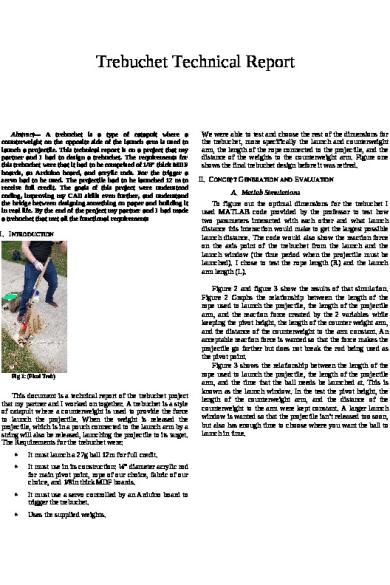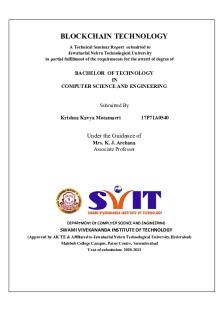Trebuchet Technical report DOCX

| Title | Trebuchet Technical report |
|---|---|
| Author | James Fox |
| File Size | 385.6 KB |
| File Type | DOCX |
| Total Downloads | 380 |
| Total Views | 691 |
Summary
Trebuchet Technical Report Fox Plainfield, IL (of Affiliation) [email protected] line 1: 2nd Given Name Surname line 2: dept. name of organization Abstract— A trebuchet is a type of catapult where a We were able to test and choose the rest of the dimensions for counterweight on the opposite side of...
Description
Trebuchet Technical Report line 1: 2nd Given Name Surname line 2: dept. name of organization (of Affiliation) Abstract— A trebuchet is a type of catapult where a counterweight on the opposite side of the launch arm is used to launch a projectile. This technical report is on a project that my partner and I had to design a trebuchet. The requirements for this trebuchet were that it had to be comprised of 1/8" thick MDF boards, an Arduino board, and acrylic rods. For the trigger a servo had to be used. The projectile had to be launched 12 m to receive full credit. The goals of this project were understood coding, improving my CAD skills even further, and understand the bridge between designing something on paper and building it in real life. By the end of the project my partner and I had made a trebuchet that met all the functional requirements I. INTRODUCTION Fig 1: (Final Treb) This document is a technical report of the trebuchet project that my partner and I worked on together. A trebuchet is a style of catapult where a counterweight is used to provide the force to launch the projectile. When the weight is released the projectile, which is in a pouch connected to the launch arm by a string will also be released, launching the projectile to its target. The Requirements for the trebuchet were: It must launch a 27g ball 12m for full credit. It must use in its construction: ¼" diameter acrylic rod for main pivot point, rope of our choice, fabric of our choice, and 1/8in thick MDF boards. It must use a servo controlled by an Arduino board to trigger the trebuchet. Uses the supplied weights. We were able to test and choose the rest of the dimensions for the trebuchet, more specifically the launch and counterweight arm, the length of the rope connected to the projectile, and the distance of the weights to the counterweight arm. Figure one shows the final trebuchet design before it was retired. II. CONCEPT GENERATION AND EVALUATION A. Matlab Simulations To figure out the optimal dimensions for the trebuchet I used MATLAB code provided by the professor to test how two parameters interacted with each other and what launch distance this interaction would make to get the largest possible launch distance. The code would also show the reaction force on the axis point of the trebuchet from the launch and the launch window (the time period when the projectile must be launched). I chose to test the rope length (R) and the launch arm length (L). Figure 2 and figure 3 show the results of that simulation. Figure 2 Graphs the relationship between the length of the rope used to launch the projectile, the length of the projectile arm, and the reaction force created by the 2 variables while keeping the pivot height, the length of the counter weight arm, and the distance of the counterweight to the arm constant. An acceptable reaction force is wanted so that the force makes the projectile go farther but does not break the rod being used as the pivot point. Figure 3 shows the relationship between the length of the rope used to launch the projectile, the length of the projectile arm, and the time that the ball needs be launched at. This is known as the launch window. In the test the pivot height, the length of the counterweight arm, and the distance of the counterweight to the arm were kept constant. A larger launch window is wanted so that the projectile isn't released too soon, but also has enough time to choose where you want the ball to launch in time....
Similar Free PDFs

ARCHITECTURAL TECHNICAL REPORT
- 7 Pages

Technical Report Engineering
- 140 Pages

Technical Report Template
- 39 Pages

Blockchain technical report
- 26 Pages

Project 2 - Trebuchet
- 9 Pages

MXB201 Technical Report 29:05:20
- 25 Pages

Technical terms
- 2 Pages

TECHNICAL ANALYSIS
- 13 Pages

Technical Articles
- 167 Pages

Technical Paper
- 13 Pages
Popular Institutions
- Tinajero National High School - Annex
- Politeknik Caltex Riau
- Yokohama City University
- SGT University
- University of Al-Qadisiyah
- Divine Word College of Vigan
- Techniek College Rotterdam
- Universidade de Santiago
- Universiti Teknologi MARA Cawangan Johor Kampus Pasir Gudang
- Poltekkes Kemenkes Yogyakarta
- Baguio City National High School
- Colegio san marcos
- preparatoria uno
- Centro de Bachillerato Tecnológico Industrial y de Servicios No. 107
- Dalian Maritime University
- Quang Trung Secondary School
- Colegio Tecnológico en Informática
- Corporación Regional de Educación Superior
- Grupo CEDVA
- Dar Al Uloom University
- Centro de Estudios Preuniversitarios de la Universidad Nacional de Ingeniería
- 上智大学
- Aakash International School, Nuna Majara
- San Felipe Neri Catholic School
- Kang Chiao International School - New Taipei City
- Misamis Occidental National High School
- Institución Educativa Escuela Normal Juan Ladrilleros
- Kolehiyo ng Pantukan
- Batanes State College
- Instituto Continental
- Sekolah Menengah Kejuruan Kesehatan Kaltara (Tarakan)
- Colegio de La Inmaculada Concepcion - Cebu





